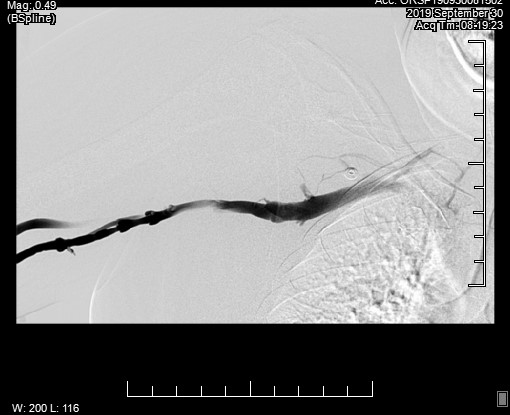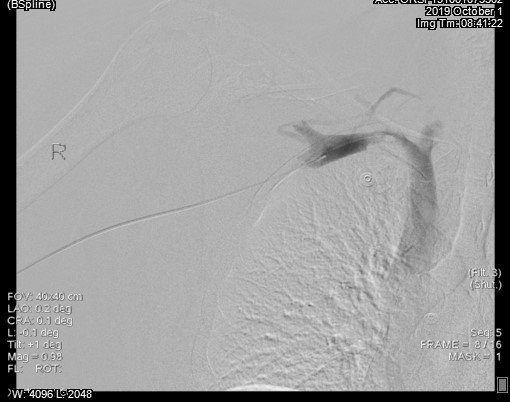Case Presentation: A 52-year-old male with medical history of diabetes mellitus, hypertension, and hyperlipidemia presented to ER for right upper extremity swelling for 3 days. He reported a feeling of heaviness in his right arm and associated pain with movement. He denied any trauma, history of blood clots, or cancer and endorsed a family history of blood clots, including his mother, grandmother, and uncle. He’s a logger and uses his arms heavily at work. Ultrasound of the right upper extremity revealed an acute DVT in the axillary and subclavian vein. X-ray of the humerus revealed no acute abnormality. Chest CT showed perivascular soft tissue stranding and edema along the right axillary and subclavian veins but did not reveal a pulmonary embolus. The patient was started on a heparin drip and vascular surgery was consulted. Vascular surgery initiated thrombolysis in the right upper extremity where complete occlusion of the right subclavian vein was found. The patient underwent thrombolysis for 3 days and had significant symptomatic improvement. During surgery, an area of narrowing at the thoracic outlet and the proximal subclavian vein with significant vascular collateralization was visualized. After completing thrombolysis he underwent balloon angioplasty of the subclavian vein with a 10 mm balloon due to continuation of sluggish flow through the subclavian vein. Ultimately the patient was transferred to a higher level of care to be evaluated for first rib resection.
Discussion: Vascular thoracic outlet syndrome (vTOS) is divided into 2 forms (arterial and venous) depending on which structure is compressed. Venous and arterial subtypes of TOS affect only 3% and <1% of all TOS patients respectively. Paget-Schroetter syndrome (PSS) or Effort thrombosis of the upper extremity refers to a deep venous thrombosis of the upper extremity resulting from repetitive activity of the upper limb. Most of these cases occur in young elite athletes performing strenuous upper extremity activity. Given the emergence of endovascular therapies in the hospital, it’s paramount to consider this vascular phenomena in any patient presenting with upper extremity pain.
Conclusions: Vascular TOS presents diagnostic and management challenges to physicians. The approach to vascular TOS is limited to a few case studies, with a scarcity of randomized controlled trials and prospective data to guide clinical practice. The initiation of prompt catheter-directed thrombolysis with early surgical decompression of the thoracic outlet is reported to produce >90% clinical success, along with anticoagulation and venoplasty of any residual stenosis to reduce risk of rethrombosis. PSS is rare, but this case illustrates the importance of high clinical suspicion for this diagnosis in this particular occupation and early treatment in the hospital providing better outcome with minimal morbidity.


